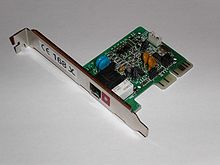Audio modem riser
Audio Modem Riser ( Latin .: Audire > listen, modem > modulate / demodulate; English : rise > Aufgang, Aufstieg) is an interface on the motherboard of some PCs for the inexpensive implementation of the input and output of speech and sound and for analog Data transfer.
Around the year 2000 , Intel developed the Audio Codec 97 based on the idea of implementing only the most necessary functions of analog inputs and outputs with hardware . The developers assumed that the processors of that time and later had sufficient power reserves to handle a large part of the required calculations. For this purpose, Intel specified the AC97 and the AMR slot for the input and output of audio and modem data.
The integration on the motherboard can be very different. In one of the most common variants, all components for audio processing are on the motherboard, the AC97 controller , the primary AC-97 codec and the plug connections for the corresponding peripheral devices . A corresponding modem riser card with the secondary modem codec and the telephone plug are required for the modem function. Boards with less integration only have the AC97 controller and the AMR slot. The AMR slot must be equipped with a corresponding expansion card for both the sound and the modem function . Modem and sound processing can also be combined on the card. There are also motherboards that do not have an AMR slot, as everything is already integrated on the board. The manufacturers still benefit from the cheap standard chips for AC97.

